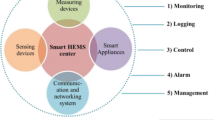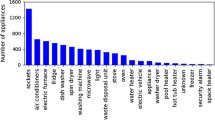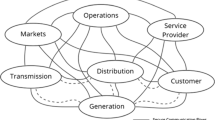Abstract
The use of mobile devices in grid environments may have two interaction aspects: devices are considered as users of grid resources or as grid resources providers. Due to the limitation constraints on energy and processing capacity of mobile devices, their integration into the Grid is difficult. In this paper, we investigate the cooperation among mobile devices to balance the energy consumption and computation workloads. Mobile devices can have different roles such as buyer devices and seller devices. In the mobile grid, the energies of mobile devices are uneven, energy-poor devices can exploit other devices with spare energy. Our model consists of two actors: A buyer device agent represents the benefits of mobile buyer device that intends to purchase energy from other devices. A seller device agent represents the profits of mobile seller device that is willing to sell spare energy to other devices. The objective of optimal energy allocation in mobile grid is to maximize the utility of the system without exceeding the energy capacity, expense budget and the deadline. A collaboration algorithm among mobile agents for efficient energy allocation is proposed. In the simulation, the performance evaluation of collaboration algorithm among mobile agents is conducted.








Similar content being viewed by others
References
Alsalih, W., Akl, S., & Hassanein, H. (2005). Energy-aware task allocation over MANETs, Wireless and Mobile Computing, Networking and Communications, 2005. (WiMobapos, 2005), IEEE press, pp. 315–322.
Chen, L., & Leneutre, J. (2008). A game theoretic framework of distributed power and rate control in IEEE 802.11 WLANs. IEEE Journal on Selected Areas in Communications, 26(7), 1128–1137.
Chen, J., Shen, H., & Tian, H. (2008). Energy balanced data gathering in WSNs with grid topologies. Seventh International Conference on Grid and Cooperative Computing (GCC), pp. 362–368.
Ernemann, C. (2002). Economic scheduling in grid computing. In Proc of 8th International Workshop Job Scheduling Strategies for Parallel Processing, Lecture Notes in Computer Science, UK, July 24, 2002, 128–152.
Huang, J.-H., & Kao, Y.-F. (2007). Price-based resource allocation strategies for wireless ad hoc networks with transmission rate and energy constraints. Computer Communications and Networks, 2007. ICCCN 2007. Proceedings of 16th International Conference on 13–16, Aug. 2007, pp. 1065–1070.
Huang, Y., Mohapatra, S., & Venkatasubramanian, N. (2005). An energy-efficient middleware for supporting multimedia services in mobile grid environments. IEEE International Conference on Information Technology.
Hummel, K. A., & Jelleschitz, G. (2007). A robust decentralized job scheduling approach for mobile peers in ad-hoc grids, cluster computing and the grid, 2007. CCGRID 2007. Seventh IEEE International Symposium on, May 2007, pp. 461–470.
Katsaros, K., & Polyzos, G. C. (2007). Optimizing operation of a hierarchical campus-wide mobile grid for intermittent wireless connectivity. IEEE LAN/MAN Workshop (LANMAN 2007).
Kim, J.-K., Siegel, H. J., Maciejewski, A. A., & Eigenmann, R. (2005). Dynamic mapping in energy constrained heterogeneous computing systems. Parallel and Distributed Processing Symposium, 2005. Proceedings. 19th IEEE International 04-08, April, 2005.
Kim, K. H., Buyya, R., & Kim, J. (2007). Power aware scheduling of bag-of-tasks applications with deadline constraints on DVS-enabled clusters. Proceedings of the Seventh IEEE International Symposium on Cluster Computing and the Grid, IEEE Computer Society, Washington, DC, USA, pp. 541–548.
Kumar, G. S. A., Manimaran, G., & Wang, Z. (2007). Energy-aware scheduling of real-time tasks in wireless networked embedded systems. 28th IEEE International Real-Time Systems Symposium, IEEE Press, pp. 15–24.
Li, C., & Li, L. (2004). Agent framework to support computational grid. Journal of Systems and Software, Elsevier, Vol 70/1–2, pp. 177–187, February, 2004.
Li, C., & Li, L. (2005). A distributed utility-based two level market solution for optimal resource scheduling in computational grid. Parallel Computing, Elsevier, USA, Vol 31/3–4, pp. 332–351, March-April, 2005.
Li, C., & Li, L. (2006). Multi economic agent interaction for optimizing the aggregate utility of grid users in computational grid. Applied Intelligence, Springer-Verlag Heidelberg, Vol 25/2, pp. 147–158, October, 2006.
Li, C., & Li, L. (2007a). Utility based QoS optimisation strategy for multi-criteria scheduling on the grid. Journal of Parallel and Distributed Computing, Vol 67/2, pp. 142–153, Elsevier, USA, February, 2007.
Li, C., & Li, L. (2007b). Joint QoS optimization for layered computational grid. Information Sciences, Vol 177/15, pp. 3038–3059, Elsevier, August 2007.
Litke, A., Skoutas, D., & Varvarigou, T. (2004). Mobile grid computing: Changes and challenges of resource management in a mobile grid environment. In Access to Knowledge through the Grid in a Mobile World Workshop, held in conjunction with 5th Int. Conf. on Practical Aspects of Knowledge Management, PAKM 2004.
Otebolaku, A. M., Adigun, M. O., Iyilade, J. S., & Ekabua, O. (2007). On modeling adaptation in context-aware mobile grid systems. Third International Conference on Autonomic and Autonomous Systems (ICAS 2007), IEEE Press.
Seshasayee, B., Nathuji, R., & Schwan, K. (2007). Energy-aware mobile service overlays: Cooperative dynamic power management in distributed mobile systems. Fourth International Conference on Autonomic Computing (ICAC’07), IEEE Press.
Shang, L., Dick, R. P., & Jha, N. K. (2002). An economics-based power-aware protocol for computation distribution in mobile ad-hoc networks. In Proc. IASTED International Conference on Parallel and Distributed Computing and Systems, pp. 344–349, Nov. 2002.
Vetri Selvi, V., Sharfraz, S., & Parthasarathi, R. (2007). Mobile ad hoc grid using trace based mobility model. C. Cérin, & K.-C. Li (Eds.), GPC 2007, LNCS 4459, pp. 274–285.
Zhou, C., Qian, D., & Lee, H. (2004). Utility-based routing in wireless ad hoc networks. Mobile Ad-hoc and Sensor Systems, 2004 IEEE International Conference on, 25–27 Oct. 2004, pp. 588–593.
Zhu, D., Melhem, R., & Mosse, D. (2005). Energy efficient configuration for QoS in reliable parallel servers. Proc. of the Fifth European Dependable Computing Conference, LNCS 3463, pp. 122–139, Apr. 2005.
Zong, Z., & Qin, X. (2007). Energy-efficient scheduling for parallel applications running on heterogeneous clusters. International Conference on Parallel Processing (ICPP 2007), IEEE Press.
Acknowledgements
The authors thank the editor and the anonymous reviewers for their helpful comments and suggestions. The work was supported by the National Natural Science Foundation of China (NSF) under grants (No. 60773211, No. 60970064), Program for New Century Excellent Talents in University, China (NCET-08-0806), Fok Ying Tong Education Foundation, China (Grant No. 121067), self-determined and innovative research funds of WUT (Grant No. 2009-II-003, 2010-ZX-031) and the Scientific and Technological Project in WuHan under Grant No. 201010621207. Any opinions, findings, and conclusions are those of the authors and do not necessarily reflect the views of the above agencies.
Author information
Authors and Affiliations
Corresponding author
Appendix: Lagrangian relaxation
Appendix: Lagrangian relaxation
Lagrangian relaxation is a relaxation technique which works by moving hard constraints into the objective so as to exact a penalty on the objective if they are not satisfied.
1.1 Mathematical description
Given an LP(linear programming) problem \( x \in {\mathbb{R}^n} \)and \( A \in {\mathbb{R}^{{m,n}}} \) of the following form:
If we split the constraints in A such that \( {A_1} \in {\mathbb{R}^{{{m_1},n}}} \), \( {A_2} \in {\mathbb{R}^{{{m_2},n}}} \) and m1 + m2 = m, we may write the system:
We may introduce the constraint (2) into the objective:
If we let \( \mathop{\lambda }\nolimits = (\mathop{\lambda }\nolimits_1, \mathop{\lambda }\nolimits_2 \cdots, \mathop{\lambda }\nolimits_{{\mathop{m}\nolimits_2 }} ) \) be nonnegative weights, we get penalized if we violate the constraint (2), and we are also rewarded if we satisfy the constraint strictly. The above system is called the Lagrangian Relaxation of our original problem.
Of particular use is the property that for any fixed set of \( \mathop{\lambda }\limits^{\sim } \) values, the optimal result to the Lagrangian Relaxation problem will be no smaller than the optimal result to the original problem. Let \( \hat{x} \) be the optimal solution to the original problem, and let \( \overline x \) be the optimal solution to the Lagrangian Relaxation. We can then see that
The first inequality is true because \( \hat{x} \) is feasible in the original problem and the second inequality is true because \( \overline x \) is the optimal solution to the Lagrangian Relaxation. This in turn allows us to address the original problem by instead exploring the partially dualized problem
where we define P(λ) as
A Lagrangian Relaxation algorithm thus proceeds to explore the range of feasible λ values while seeking to minimize the result returned by the inner P problem. Each value returned by P is a candidate upper bound to the problem, the smallest of which is kept as the best upper bound. If we additionally employ a heuristic, probably seeded by the \( \overline x \) values returned by P, to find feasible solutions to the original problem, then we can iterate until the best upper bound and the cost of the best feasible solution converge to a desired tolerance.
Rights and permissions
About this article
Cite this article
Li, C., Li, L. Collaboration among mobile agents for efficient energy allocation in mobile grid. Inf Syst Front 14, 711–723 (2012). https://doi.org/10.1007/s10796-011-9298-9
Published:
Issue Date:
DOI: https://doi.org/10.1007/s10796-011-9298-9




